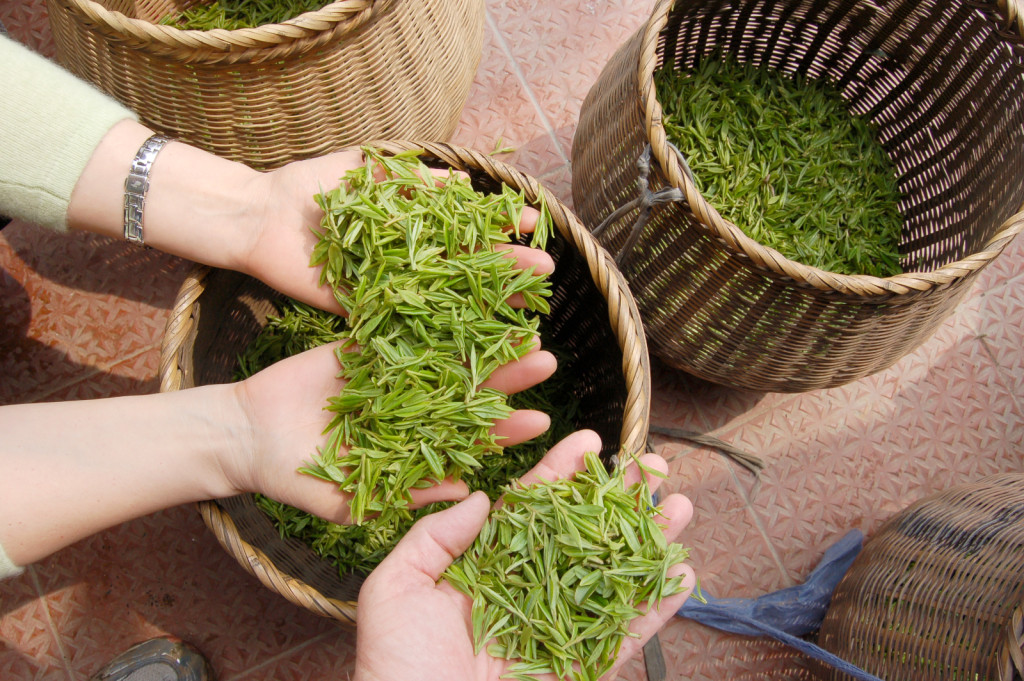
The Famous Zhong Guo Shi Da Ming Cha List
Throughout the modern history of marketing Chinese tea, a list of teas, known as the Zhong Guo Shi Da Ming Cha (中国十大名茶), or “The Ten Famous Teas of China” is frequently mentioned. There is not just one list, but many of them, appearing in various forms throughout the last hundred years. Government agricultural bureaus, business associations, and magazines have all published their versions, with each list representing the standards and preferences of their time.
To complicate things further, there are twenty-one provinces producing tea in China, and each one of these provinces is apt to promote its list of locally famous teas. Altogether, there are easily more than a thousand named teas in China produced to high standards of quality. In light of the staggering number of highly regarded Chinese teas today, it’s important to think of these lists as a starting point rather than an exhaustive survey of all Chinese tea.
Still, lists are handy. If you’re looking to know (and taste) some of the greatest teas in the world, you can begin with a list like this and get off to a great start.
The 10 Famous Teas of China
To help update this tradition we’ve assembled our own list of China’s 10 Most Famous teas. The list below pays honor to the famous names mentioned in earlier lists while also representing the diversity of styles of high-quality Chinese tea today.
Xi Hu Long Jing 西湖龙井 (West Lake Dragon Well) – Hangzhou City, Zhejiang Province
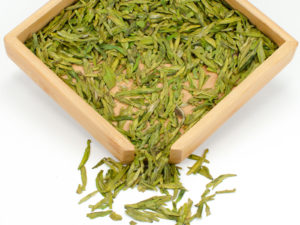
“West Lake” refers to all tea production in the villages surrounding the large lake in Hangzhou, including Mei Jia Wu and the most prestigious, Shi Feng, at the top of its mountain. This was a well-known tribute tea for centuries. A temple and emperor’s tea garden still exist there. Our Shifeng Longjing (Shifeng Dragon Well) comes from the Weng family, which has been making tea by hand for generations. This style has been replicated in other regions, notably in Xin Chang as Da Fo Long Jing.
Dong Ting Bi Luo Chun 洞庭碧螺春 – Tai Lake, Suzhou City, Jiangsu Province
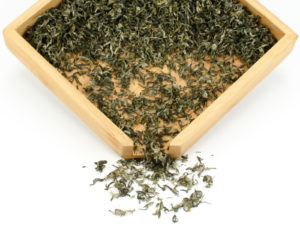
Tai Lake is the third-largest freshwater lake in all of China. Tea produced here is grown on the Dongshan (East Mountain) Peninsula and the Xishan (West Mountain) island. Tea from the island is considered superior because of its environment: mist from the lake shelters the tea bushes, while an abundance of fruit trees growing alongside them contributes to its flavor. Our Bi Luo Chun comes from the Lu Family living in Xishan.
Huangshan Maofeng 黄山毛峰 (Yellow Mountain) – Huangshan City, Anhui Province
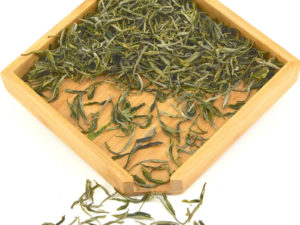
Huang Shan (Yellow Mountain) is a site of tremendous natural heritage in China and is home to the highest peak on the country’s eastern side. Tea makers in this area were the first to make green tea in the modern style of frying the leaves and finishing them as loose leaf tea. Huang Shan has had an enormous influence on Chinese tea culture, exporting its tea-making style all over China. Our Huangshan Maofeng (Yellow Mountain) is made by a 5th generation tea maker, Wang Fang Shen, who invented the flowering display tea ball in 1986. His Huang Shan Mao Feng and display teas are frequently given as gifts from the Chinese diplomatic corps to leaders of other countries.
Lu’an Gua Pian 六安瓜片 (Sunflower Seed) – Jin Zhai County, Anhui Province
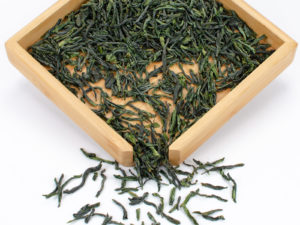
Gua Pian is commonly mistranslated as “Melon Seed” but is more appropriately translated as “Sunflower Seed.” This unique tea is the only green tea to use a one-leaf plucking standard that includes neither bud nor stem. Lu’an Gua Pian (Sunflower Seed) is also the only tea to be dried to completion by the unusual method of firing over an open flame. You can read about the special processing of this tea in more detail on our tea blog.
Junshan Yin Zhen 君山银针 (Junshan Island Silver Needle) – Yue Yang City, Hunan Province
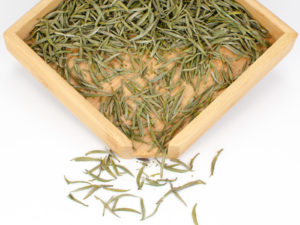
Jun Shan is a mountain island in China’s second largest freshwater lake. Tea from this island was a tribute tea in the Qing Dynasty. Modern Jun Shan Yin Zhen is harvested during a very narrow window time, just seven to ten days at the end of March and beginning of April. At this particular time, the tea buds have grown close to three centimeters long and have not opened into leaves, though they are mature in flavor. As a yellow tea, Jun Shan Yin Zhen is time-consuming and complicated to produce. Our Junshan Yinzhen is made from 85% tea buds and 15% one bud to one leaf. For more about the meticulous production of this tea, refer to Junshan Yinzhen’s dedicated page.
Baihao Yinzhen 白毫银针 (Silver Needle) – Fuding County, Fujian Province
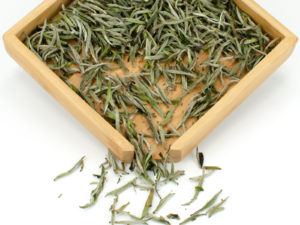
The most prized of white teas, defined by its fine all-bud plucking standard and careful low-temperature drying. Its name is derived from the fine silvery fuzz on the young tea buds and their pointed shape.
Records of Baihao Yinzhen as a style date back to the 18th century, but it wasn’t until the late 20th century that this tea became popular with domestic Chinese and Western tea drinkers alike. The style originated in Fuding County but also has a long history in its neighboring areas around northern Fujian. Our Baihao Yinzhen (Silver Needle) is grown in an organic garden in Shaowu prefecture. In league with the best Silver Needle available, it comes from the first harvest of the spring with a stout, full bud. Its infusion gives off a breezy meadow-like aroma with a flavor that’s clean, mellow, and sweet.
Wuyi Yancha 武夷岩茶 (Wuyi Rock Tea) – Wuyishan City, Fujian Province
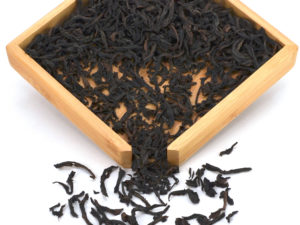
The skills of making wulong tea were first developed in Wuyishan (also written as Wuyi Mountain). The area’s yancha (or “rock wulong”) is still the most conservative style wulong tea produced today. This tea is still made by the traditional method using open leaves that are naturally oxidized and dried over charcoal. The modern way of producing wulong tea now uses ovens.
There are many varieties of yan cha developed from the diverse variety of tea bushes in Wuyishan, but by far the most famous name in Wuyi Yan Cha is Da Hong Pao 大红袍(Big Red Robe), a tea made as a masterful blend, incorporating the diversity of Wuyishan tea bushes into a cohesive whole. An infusion of Da Hong Pao presents dark mineral and stone fruit flavors with floral and incense wood aromas.
Qimen Hong Cha 祁门红茶 (Keemun Black Tea) – Qimen County, Anhui Province
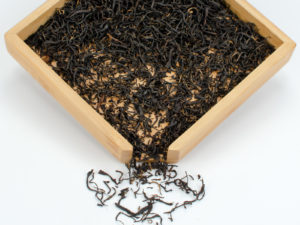
Though relatively few people in China consume black tea, Qimen (Keemun) is still highly regarded for its unusual floral character. Qimen gained a boost in popularity during the reform period when Deng Xiaoping suggested, “let Qimen be known to the world.” We carry Caixia Qimen (Sunrise Keemun), harvested at the unusually early one bud to one tender leaf plucking standard. Using leaves this young means this is an especially difficult black tea to make.
Puer Tea 普洱 – Pu’er City, Yunnan Province
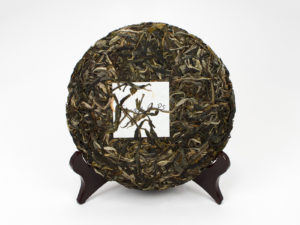
Puer Tea (also romanized as Pu-erh) is nearly a world unto itself, a broad style spanning dozens of micro-origins across the Rainforest highlands of Yunnan province in China’s deep southwest. There’s a lot to be said here, so we’ve written a much more comprehensive introduction to the style, which you can find here.
As for a single tea that sums up this diverse style into one gold standard example, we recommend sheng Puer from Xishuangbanna, specifically Youle Huangshancha (Youle Forest Tea) made from the old-growth tea trees on Youle Mountain, one of the old “Six Famous Mountains” of puer tea. Within comes the hallmark qualities of Sheng Puer that set it apart from every other style in the world: bright, fruity aromas with complex herbal flavors that swing into a dynamic mix of bitterness and sweetness.
Bi Tan Piao Xue 碧潭飘雪 (Snow Drop Jasmine) – Ya’an, Sichuan Province
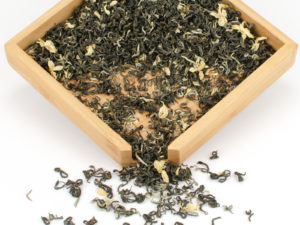
People have likely scented their tea leaves with other aromatic flowers, herbs, and fruits for as long as tea has been a beverage. Among these mixtures, none are more celebrated than the pairing of green tea with fresh jasmine flowers. And among all of the Jasmine scented green teas, none are more famous than the poetically named Bi Tan Piao Xue.
Snow Drop Jasmine Posesses distinct qualities of both spring green tea and pure jasmine flowers, as well as smooth aromatic highs created in their unison.
Other lists of famous teas
For comparison’s sake, the following are other lists of famous Chinese tea that have appeared over the last century. It’s interesting to see the shifts in what is selected and what is passed over. For instance, Yunnan Puer tea only first appeared on the list in 1999, whereas the tea was not widely appreciated before then.
1915
Published for the Panama World Expo:
- Xi Hu Long Jing
- Bi Luo Chun
- Xin Yang Mao Jian
- Du Yun Mao Jian
- Liu An Gua Pian
- Jun Shan Yin Zhen
- Tie Guan Yin
- Huang Shan Mao Feng
- Wuyi Yan Cha
- Qimen Hong Cha
1999
Published in newsprint by a Chinese tea trade group:
- Jiangsu Bi Luo Chun
- Xi Hu Long Jing
- Huang Shan Mao Feng
- Liu An Gua Pian
- Jiangxi Yun Wu Cha
- [Hubei] En Shi Yu Lu (related to the Japanese made “Gyokuro”)
- Fujian Tie Guan Yin
- Fujian Yin Zhen (Bai Hao Yin Zhen)
- Yunnan Puer Tea
- Fujian Yan Cha
2001
Published by a Chinese governmental tea organization:
- Xi Hu Long Jing
- Huang Shan Mao Feng
- Dong Ting Bi Luo Chun
- Liu An Gua Pian
- Meng Ding Gan Lu
- Lu Shan Yun Wu Cha
- Xin Yang Mao Jian
- Du Yu Mao Jian
- Anxi Tie Guan Yin
- Suzhou Mo Li Hua
2002
Published by a Hong Kong Newspaper:
- Xi Hu Long Jing
- Jiangsu Bi Luo Chun
- Huang Shan Mao Feng
- Liu An Gua Pian
- Fujian Bai Hao Yin Zhen
- Qimen Hong Cha
- Du Yu Mao Jian
- Xin Yang Mao Jian
- Wuyi Yan Cha
- Fujian Tie Guan Yin

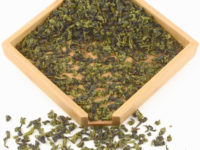 Jin Guanyin (Golden Tieguanyin) 2024
Jin Guanyin (Golden Tieguanyin) 2024